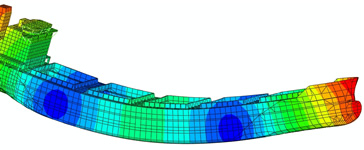
Every object in the nature has endless number of vibration frequencies and mode shapes that are called "Natural Frequencies". Calculation of these frequencies and their mode shapes are important to solve the vibration induced engineering problems. Natural frequencies and mode shapes of simple objects can be found by using analytical methods. However, complex shaped objects can only be analyzed by numerical methods. Finite element methods and the improved computer calculation capacities enable to investigate the natural frequencies and mode shapes of complex structures by idealizing them into computable small parts which are called "finite elements".
Vibration analyses can be divided into two main parts. These are;
Some situations may arise where avoiding from resonance is not possible especially in complex structures. In that case, the vibration levels should be known. Forced vibration analyses can be applied to calculate the structure's vibration response (displacement, velocity and acceleration) to excitation frequencies.
Resonance induced displacements and stress values may cause structural damages, fatigue and discomfort crew or passenger environment.
In forced vibration analyses, excitation forces and their frequencies as well as structure's natural frequencies need to be known. Sometimes excitation forces are not easy to calculate as magnitude and/or as frequency in vibration problems. For example, wind stream induced excitation forces and frequencies around a suspension bridge or propeller thrust fluctuations after a ship body advancing in irregular seas. On the other hand, material and structure's damping characteristics should also be specified very carefully to obtain good results as close as possible to reality.
Other important matter in vibration analyses is the effect of the surrounding fluid around the structure which significantly alters its vibration response by frequency dependent added mass effect. This is defined as structure-fluid interaction and especially important for ships global hydro-elastic vibration characteristics. Analyses regarding ships global response without taking the surrounding fluid effects yield wrong results.
MESH, accomplishes the uncertainties in the vibration analyses either by using other engineering tools or using own wide experiences.